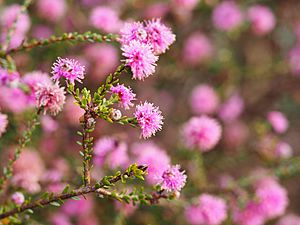Melaleuca tuberculata facts for kids
Melaleuca tuberculata is a small, bushy plant from the myrtle family. It only grows in the south-west part of Western Australia. This plant is special because it has three different types, called varieties. Each variety has leaves of a different size and shape. They also grow in slightly different places and like different kinds of soil.
Quick facts for kids Melaleuca tuberculata |
|
|---|---|
 |
|
| M. tuberculata (leaves, flowers, fruit) | |
| Scientific classification | |
| Genus: |
Melaleuca
|
| Species: |
tuberculata
|
Contents
What Does Melaleuca tuberculata Look Like?
Melaleuca tuberculata is a shrub that can grow from about 0.2 m (0.7 ft) (8 inches) to 2 m (7 ft) (6.5 feet) tall. Its leaves are placed one after another along the stem. They are 2–19 mm (0.08–0.7 in) long and 0.8–3.5 mm (0.03–0.1 in) wide. The leaves can be long and thin or narrow and oval-shaped.
Flowers and Fruit
The flowers grow in round groups, up to 25 mm (1 in) (1 inch) across. These groups are found at the ends of the branches. Each group has one to seven smaller clusters of flowers, with three flowers in each cluster.
At the bottom of the flowers, there are hairy brown bracts (small leaf-like parts). The flower buds are covered with soft, white hairs. The flowers bloom from August to December. Their color can be light to medium pink or purple.
The flower has stamens (the parts that make pollen) arranged in five groups. Each group has six to ten stamens. The bright yellow anthers (tips of the stamens) stand out against the purple threads. The cup-shaped base of the flower is hairy and 1.5–3 millimetres (0.06–0.1 in) long. After flowering, the plant produces woody capsules (seed pods). These capsules are 3–4 mm (0.1–0.2 in) long and wide.
Different Varieties
There are three main types, or varieties, of Melaleuca tuberculata. You can tell them apart by the size of their leaves:
- var. arenia: Leaves are 2–4.2 mm (0.08–0.2 in) long and 1.1–2.3 mm (0.04–0.09 in) wide.
- var. macrophylla: Leaves are 4.5–18.5 mm (0.2–0.7 in) long and 1.2–3.5 mm (0.05–0.1 in) wide.
- var. tuberculata: Leaves are 2.5–13.5 mm (0.1–0.5 in) long and 0.8–1.3 mm (0.03–0.05 in) wide.

How Did It Get Its Name?
The plant Melaleuca tuberculata was first officially described in 1844. This was done by a person named Johannes Conrad Schauer in a book called Plantae Preissianae.
The second part of its name, tuberculata, comes from a Latin word. This word means "full of lumps." It refers to the small, raised oil glands that are easy to see on the leaves of the plant.
Where Does It Grow?
Melaleuca tuberculata grows in several natural areas of Western Australia. These areas include the Avon Wheatbelt, Esperance Plains, Jarrah Forest, and Mallee regions. It likes to grow in different types of soil, often over ironstone or laterite rock. You can find it on rolling plains and in higher areas.
Where Each Variety Grows
Each variety of the plant grows in slightly different places:
- var. arenia: Found in the area around Bendering, Kulin, Hyden, and Pingaring.
- var. macrophylla: Grows from the Kulin and Jerramungup area eastwards. It reaches as far as Grass Patch and Israelite Bay.
- var. tuberculata: Found from the Brookton and Narrogin area eastwards. It extends to the Esperance and Israelite Bay district.
Is It Endangered?
The Government of Western Australia Department of Parks and Wildlife has looked at this plant. They have classified Melaleuca tuberculata as "not threatened." This means it is not currently in danger of disappearing.

